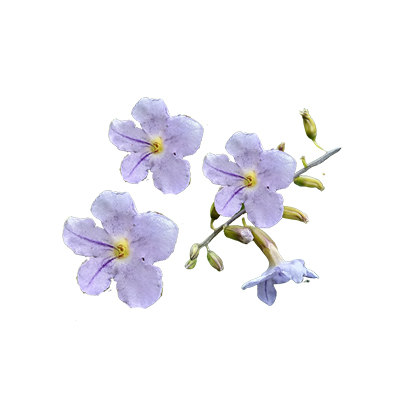Golden Dewdrop
Duranta erecta L.
Verbenaceae
Location in our garden
Beneficial Weed



Synonym
Duranta angustifolia Salibs.
Duranta dentata Pers.
Duranta inermis L.
Habitus
Shrubs. An evergreen shrub or small tree, often climbing, with multiple branches that droop towards the ground, growing up to 7 m in height.
Part Used
Leaves
Flowers
Fruit
Growing Requirements
Full Sunshine
Need Shade
Habitat
Riverbanks
Forest
Coastal
Roadside
Shrublands
Grassland
Terrestrial
Overview
Golden dewdrop is reported to be native to Mexico, the Caribbean, Central America and much of South America. It is also native to the states of Arizona, California, Florida, Louisiana and Texas in the USA. This species is widely cultivated across the world and has become naturalized in parts of Asia, Africa, the Indian Ocean islands of Mayotte and Reunion and much of Oceania. The plant is harvested from the wild for local use as a medicine and insect repellent. It is widely cultivated as an ornamental and also used as a hedges plants in the subtropical and tropical zones. The leaves and fruits are poisonous to people and animals and they are reported to have caused the poisoning of domestic cats and dogs.
Vernacular Names
Jia lian qiao (Chinese), Durante dressée, Vanilier de cayenne (French), Bharangi (India), Cuentas de oro, San Jacinto (Spanish), Thanh yod (Thai), Thanh quan (Vietnamese), Duranta (Philippines), Durante, Taubenbeere (German), Duranta, Fruta-de-jacú, Pingo-de-ouro, Violeteira (Portuguese), Deyuranta, Harimatsuso (Japan).
Agroecology
Golden dewdrop occurs in scrub, open woodlands and disturbed areas. It is also associated with riparian habitats, coastal hills, grasslands, densely forested areas and roadsides, at elevations from 150-1,650 m. Golden dewdrop tolerates acidic to slightly alkaline soils and is moderately salt tolerant. It prefers a position in full sun and tolerant of semi-shade, growing well in a moist, fertile, well-drained soil. Annual rainfall is usually between 800 mm and 1,800 mm.
Morphology
- Roots - taproot.
- Stem - several stem or drooping spiny branches, especially when carrying large number of fruit. Pubescent when young. Younger stems are green in colour. The bark is light gray, becoming rough, and fissured when old. There are usually at least some pairs of spines along the stems, one located at the base of each of the leaf stalks.
- Leaves - simple, light‑green, elliptic to ovate, paired, opposite, base cuneate, margin entire to distally crenate, acute apex, surface glabrous, veins 6 pairs, have short leaf stalks.
- Flowers - hanging in long racemes (approx. 15 cm) and are small, tubular flowers are 5-lobed and colour range from purple and white to violet or blue. Calyx pubescent on both surfaces. Corolla tube ca 7 mm. Stamens inserted above the middle of the corolla-tube, anthers are oblong.
- Fruits - subglobose or obpyriform, approximately 7-10 mm in diameter, orange-yellow in colour, fleshy, glabrous. They occur in large, hanging clusters.
- Seeds - show a presence of oily embryo with little or absence of endosperm.
Cultivation
- Propagated by seeds - Best sown as soon as it is ripe in a partially shaded position in a nursery seedbed. A germination rate of less than 20% can be expected, with the seed sprouting within 90 - 110 days.
- Vegetatively propagated by stem cuttings.
Chemical Constituents
Glucosides, saponins, durantosides I, II, III, IV, and V, oleanolic acid, ursolic acid, (E)-cinnamic acid, beta-cytosteryl-3-O-beta-D-glucopyranoside, (E)-p-acid methoxycinnamate, kusaginin, alkaloids, flavonoids, steroids, triterpenoids, tannins, phenols, anthocyanins, oxalate, rutin, epicatechin, lunamarine, sapogenins, ribalinidine, phytate, kaempferol, catechin, duranterectosides A, B, C, and D, lamiide, lamiidoside, lamiidoside, verbascoside.
Traditional Medicinal Uses
- Studies have suggest mosquitocidal, thrombin inhibitory, cytotoxic, antiviral, antimalarial, antioxidant, antifungal, antiurolithiatic properties.
- The plant is used in the treatment of fevers, skin itches.
- Flowers are believed to be stimulant.
- Leaves used for treatment of abscesses and infusion of leaves and juice of fruit are diuretic.
- In Bangladesh, tribal and mainstream use for malaria. Also used by mainstream Kavirajes as insect repellent, treatment of itches, infertility, fever, and pneumonia.
- In Andhra Pradesh, India, decoction of whole plant used for asthma, bronchitis, and fever.
- In India, leaves used for treatment of cataracts.
- In the southeastern part of Nigeria, fruits used for treatment of malaria, abscesses, and parasitism.
Part Used
Reference Sources
- Royal Botanical Garden. 2021. Plants of the World Online: Duranta erecta L. http://www.plantsoftheworldonline.org/taxon/urn:lsid:ipni.org:names:330606-2. 18-09-2021.
- Useful Tropical Plant Database. 2021. Duranta erecta. https://tropical.theferns.info/viewtropical.php?id=Duranta+erecta. 18-09-2021.
- Stuartxchange. 2018. Philippines Medicinal Plant: Duranta. http://www.stuartxchange.org/Duranta. 18-09-2021.
- CAB International. 2021. Invasive Species Compendium: Duranta erecta (golden dewdrop). https://www.cabi.org/isc/datasheet/20192#touses. 18-09-2021.
- Flora Fauna Web. 2019. Duranta erecta L. https://www.nparks.gov.sg/florafaunaweb/flora/1/9/1976. 18-09-2021.


